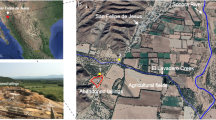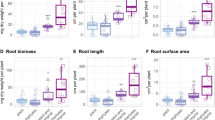Abstract
Past mining activities have left a legacy of abandoned mine tailing deposits whose metal contaminants poses serious risks to ecosystems and human health. While the development of a vegetated cover in mine tailings can help in mitigating these risks, the local factors limiting plant establishment in these sites are not well understood, restricting phytostabilization efforts. Here, we explore some of the barriers that limit seedling establishment of two species (Vachellia farnesiana and Prosopis velutina) in a mine tailing deposit located in Nacozari, Sonora, Mexico, and assess whether compost addition can help in overcoming these barriers in pot and field experiments. Our field observations found 20 times more carbon and at least 4 times more nitrogen concentration in areas under vegetated patches than in non-vegetated areas, while a previous study found no difference in metal concentrations and other physicochemical parameters. This suggests that organic matter and nutrients are a major limitation for plant establishment. In agreement with this, species failed to establish without compost addition in the field experiment. Compost addition also had a positive effect on biomass accumulation, pH and microbial activity, but increased the substrate soluble concentration of As, Cu, and Zn. Nonetheless, only Cu, K, and Mo in P. velutina accumulated in tissues at levels considered toxic for animal consumption. Our study documents that compost addition facilitated plant establishment for the phytostabilization of mine tailings and help to prevent the dispersion of most metal contaminants via animal consumption. We encourage the use of complementary strategies to minimize the risk of dispersion of metal contaminants.






Similar content being viewed by others
References
Acosta JA, Abbaspour A, Martínez GR, Martínez-Martínez S, Zornoza R, Gabarrón M, Faz A (2018) Phytoremediation of mine tailings with Atriplex halimus and organic/inorganic amendments: a five-year field case study. Chemosphere 204:71–78. https://doi.org/10.1016/j.chemosphere.2018.04.027
Alef K (1995) Soil respiration. In: Alef K, Nannipieri P (eds) Methods in applied soil microbiology and biochemistry. Academic Press, London, pp 214–222
Alvarado VJ, Volke TL (2004) Informe de resultados del proyecto, metodo de analisis y propuesta para el manejo de los residuos mineros del sitio de Nacozari, Sonora. SEMARNAT-INE, Mexico (in Spanish)
Asensio V, Vega FA, Singh BR, Covelo EF (2013) Effects of tree vegetation and waste amendments on the fractionation of Cr, Cu, Ni, Pb and Zn in polluted mine soils. Sci Total Environ 443:446–453. https://doi.org/10.1016/j.scitotenv.2012.09.069
Bacchetta G, Cappai G, Carucci A, Tamburini E (2015) Use of native plants for the remediation of abandoned mine sites in Mediterranean semiarid environments. Bull Environ Contam Toxicol 94:326–333. https://doi.org/10.1007/s00128-015-1467-y
Bolan N, Kunhikrishnan A, Thangarajan R, Kumpiene J, Park J, Makino T, Kirkham MB, Scheckel K (2014) Remediation of heavy metal(oid)s contaminated soils – to mobilize or to immobilize? J Hazard Mater 266:141–166. https://doi.org/10.1016/j.jhazmat.2013.12.018
Brady NC, Weil RR (2017) The nature and properties of soils. Pearson, Columbus, Ohio
Colin Y, Goberna M, Verdú M, Navarro-Cano JA (2019) Successional trajectories of soil bacterial communities in mine tailings: the role of plant functional traits. J Environ Manag 241:284–292. https://doi.org/10.1016/j.jenvman.2019.04.023
Conesa HM, Faz Á, Arnaldos R (2007) Initial studies for the phytostabilization of a mine tailing from the Cartagena-La Union Mining District (SE Spain). Chemosphere 66:38–44. https://doi.org/10.1016/j.chemosphere.2006.05.041
Cross AT, Ivanov D, Stevens JC, Sadler R, Zhong H, Lambers H, Dixon KW (2019) Nitrogen limitation and calcifuge plant strategies constrain the establishment of native vegetation on magnetite mine tailings. Plant Soil. https://doi.org/10.1007/s11104-019-04021-0
Fernandez S, Poschenrieder C, Marcenò C, Gallego JR, Jimenez-Gamez D, Bueno A, Afif E (2017) Phytoremediation capability of native plant species living on Pb-Zn and Hg-As mining wastes in the Cantabrian range, north of Spain. J Geochem Explor 174:10–20. https://doi.org/10.1016/j.gexplo.2016.05.015
Forján R, Asensio V, Rodríguez-Vila A, Covelo EF (2016) Contribution of waste and biochar amendment to the sorption of metals in a copper mine tailing. CATENA 137:120–125. https://doi.org/10.1016/j.catena.2015.09.010
García-Carmona M, García-Robles H, Turpín Torrano C, Fernández Ondoño E, Lorite Moreno J, Sierra Aragón M, Martín Peinado FJ (2019) Residual pollution and vegetation distribution in amended soils 20 years after a pyrite mine tailings spill (Aznalcóllar, Spain). Sci Total Environ 650:933–940. https://doi.org/10.1016/j.scitotenv.2018.09.092
Gil-Loaiza J, White SA, Root RA, Solís-Dominguez FA, Hammond CM, Chorover J, Maier RM (2016) Phytostabilization of mine tailings using compost-assisted direct planting: translating greenhouse results to the field. Sci Total Environ 565:451–461. https://doi.org/10.1016/j.scitotenv.2016.04.168
Ginocchio R, León-Lobos P, Arellano EC, Anic V, Ovalle JF, Baker AJM (2017) Soil physicochemical factors as environmental filters for spontaneous plant colonization of abandoned tailing dumps. Environ Sci Pollut Res 24:13484–13496. https://doi.org/10.1007/s11356-017-8894-8
Isermeyer H (1952) Eine einfache Methode zur Bestimmung der Bodenatmung und der Karbonate im Boden. Z Pflanzenemäh Bodenk 56:26–38
Kabata-Pendias A (2011) Trace elements in soils and plants, 4th edn. CRC Press, Boca Raton
Kato T, Kamijo T, Hatta T, Tamura K, Higashi T (2005) Initial soil formation processes of volcanogenous regosols (scoriacius) from Miyake-Jima Island, Japan. Soil Sci Plant Nutr 51:291–301. https://doi.org/10.1111/j.1747-0765.2005.tb00033.x
Kennen K, Kirkwood N (2015) Phyto: principles and resources for site remediation and landscape design. Routledge, London
Kossoff D, Dubbin WE, Alfredsson, et al (2014) Mine tailings dams: characteristics, failure, environmental impacts, and remediation. Appl Geochem 51: 229–245. https://doi.org/10.1016/j.apgeochem.2014.09.010
Lee S-H, Ji W, Lee W-S, Koo N, Koh IH, Kim MS, Park JS (2014) Influence of amendments and aided phytostabilization on metal availability and mobility in Pb/Zn mine tailings. J Environ Manag 139:15–21. https://doi.org/10.1016/j.jenvman.2014.02.019
Li X, Huang L (2015) Toward a new paradigm for tailings phytostabilization – nature of the substrates, amendment options, and anthropogenic pedogenesis. Crit Rev Environ Sci Technol 45:813–839. https://doi.org/10.1080/10643389.2014.921977
Link DD, Walter PJ, Kingston M (1998) Development and validation of the new EPA microwave-assisted leach method 3051A. Environ Sci Technol 32:3628–3632
Lottermoser BG (2010) Mine wastes. Characterization, treatment and environmental impacts. Springer, New York
Martinez-Yrizar A, Felger RS, Burquez A (2010) Los ecosistemas terrestres: un diverso capital natural. In: Molina-Freaner FE, Van-Devender TR (eds) Diversidad biológica de Sonora. Ciudad de México, CONABIO-UNAM, pp 129–156 (in Spanish)
Mendez MO, Maier RM (2008) Phytostabilization of mine tailings in arid and semiarid environments – an emerging remediation technology. Environ Health Perspect 116:278–283. https://doi.org/10.1289/ehp.10608
Meza-Figueroa D, Maier RM, de la O-Villanueva M, Gómez-Alvarez A, Moreno-Zazueta A, Rivera J, Campillo A, Grandlic CJ, Anaya R, Palafox-Reyes J (2009) The impact of unconfined mine tailings in residential areas from a mining town in a semi-arid environment: Nacozari, Sonora, Mexico. Chemosphere 77:140–147. https://doi.org/10.1016/j.chemosphere.2009.04.068
Moynahan OS, Zabinski CA, Gannon JE (2002) Microbial community structure and carbon-utilization diversity in a mine tailings revegetation study. Restor Ecol 10:77–87. https://doi.org/10.1046/j.1526-100X.2002.10108.x
Navarro-Cano JA, Goberna M, Verdú M (2019) Using plant functional distances to select species for restoration of mining sites. J Appl Ecol 56:2353–2362. https://doi.org/10.1111/1365-2664.13453
Novo LAB, González L (2014) Germination and early growth of Brassica juncea in copper mine tailings amended with technosol and compost. Sci World J 2014:1–9. https://doi.org/10.1155/2014/506392
NRC (National Research Council) (2005) Mineral tolerance of animals, 2nd revised edn. National Academies Press, Washington, DC
Ortiz-Calderón C, Alcaide Ó, Kao J (2008) Copper distribution in leaves and roots of plants growing on a copper mine-tailing storage facility in northern Chile. Rev Chil Hist Nat 81. https://doi.org/10.4067/S0716-078X2008000400004
de la O-Villanueva M, Meza-Figueroa D, Maier RM et al (2013) Procesos erosivos en jales de la presa I de Nacozari de Garcia, Sonora y su efecto en la dispersión de contaminantes. Bol Soc Geol Mex 65:27–38 (in Spanish)
Parra A, Zornoza R, Conesa E, Gómez-López MD, Faz A (2016) Evaluation of the suitability of three Mediterranean shrub species for phytostabilization of pyritic mine soils. Catena 136:59–65. https://doi.org/10.1016/j.catena.2015.07.018
Parraga-Aguado I, Querejeta JI, González-Alcaraz MN, Jiménez-Cárceles FJ, Conesa HM (2014) Usefulness of pioneer vegetation for the phytomanagement of metal(loid)s enriched tailings: grasses vs. shrubs vs. trees. J Environ Manag 133:51–58. https://doi.org/10.1016/j.jenvman.2013.12.001
Ponce de Leon-Hill C, Hernandez-Quiroz M, Venegas-Perez C, Cram-Heydrich S (2012) Conceptos y procedimientos para el análisis de muestras ambientales. Facultad de Ciencias de la Universidad Nacional Autónoma de México, Ciudad de México (in Spanish)
van Reeuwijk LP (1992) Procedures for soil analysis, 3rd edn. International Soil Reference and Information Center (ISRIC), Wageningen, the Netherlands
Rodríguez L, Gómez R, Sánchez V, Villaseñor J, Alonso-Azcárate J (2018) Performance of waste-based amendments to reduce metal release from mine tailings: one-year leaching behaviour. J Environ Manag 209:1–8. https://doi.org/10.1016/j.jenvman.2017.12.031
Rodríguez-Vila A, Covelo EF, Forján R, Asensio V (2014) Phytoremediating a copper mine soil with Brassica juncea L., compost and biochar. Environ Sci Pollut Res 21:11293–11304. https://doi.org/10.1007/s11356-014-2993-6
Romero FM, Armienta MA, Gutiérrez ME, Villaseñor G (2008) Factores geológicos y climáticos que determinan la peligrosidad y el impacto ambiental de jales mineros. Rev Int Contam Ambient 24:43–54 (in Spanish)
Santini TC, Banning NC (2016) Alkaline tailings as novel soil forming substrates: reframing perspectives on mining and refining wastes. Hydrometallurgy 164:38–47. https://doi.org/10.1016/j.hydromet.2016.04.011
Santos AE, Cruz-Ortega R, Meza-Figueroa D, Romero FM, Sanchez-Escalante JJ, Maier RM, Neilson JW, Alcaraz LD, Molina Freaner FE (2017) Plants from the abandoned Nacozari mine tailings: evaluation of their phytostabilization potential. PeerJ 5:e3280. https://doi.org/10.7717/peerj.3280
SAS Institute (2012) JMP 12. SAS Institute Inc., Cary
Schwab P, Zhu D, Banks MK (2007) Heavy metal leaching from mine tailings as affected by organic amendments. Bioresour Technol 98:2935–2941. https://doi.org/10.1016/j.biortech.2006.10.012
Shu WS, Ye ZH, Zhang ZQ, Lan CY, Wong MH (2005) Natural colonization of plants on five lead/zinc mine tailings in southern China. Restor Ecol 13:49–60. https://doi.org/10.1111/j.1526-100X.2005.00007.x
SMN (Servicio Meteorológico Nacional) (2019) Available in: https://smn.conagua.gob.mx/es/informacion-climatologica%2D%2D+-por-estado?estado=son. Accessed May 2019 (in Spanish)
Solís-Dominguez FA, White SA, Hutter TB, Amistadi MK, Root RA, Chorover J, Maier RM (2012) Response of key soil parameters during compost-assisted phytostabilization in extremely acid tailings: effect of plant species. Environ Sci Technol 46:1019–1027. https://doi.org/10.1021/es202846n
Tardif A, Rodrigue-Morin M, Gagnon V, Shipley B, Roy S, Bellenger JP (2019) The relative importance of abiotic conditions and subsequent land use on the boreal primary succession of acidogenic mine tailings. Ecol Eng 127:66–74. https://doi.org/10.1016/j.ecoleng.2018.11.003
Tateno R, Tatsumi C, Nakayama M, Takahashi K, Kerfahi D, Adams J (2019) Temperature effects on the first three years of soil ecosystem development on volcanic ash. Catena 172:1–10. https://doi.org/10.1016/j.catena.2018.08.009
Touceda-González M, Álvarez-López V, Prieto-Fernández Á, Rodríguez-Garrido B, Trasar-Cepeda C, Mench M, Puschenreiter M, Quintela-Sabarís C, Macías-García F, Kidd PS (2017) Aided phytostabilisation reduces metal toxicity, improves soil fertility and enhances microbial activity in Cu-rich mine tailings. J Environ Manag 186:301–313. https://doi.org/10.1016/j.jenvman.2016.09.019
Valentín-Vargas A, Root RA, Neilson JW, Chorover J, Maier RM (2014) Environmental factors influencing the structural dynamics of soil microbial communities during assisted phytostabilization of acid-generating mine tailings: a mesocosmos experiment. Sci Total Environ 500-501:314–324. https://doi.org/10.1016/j.scitotenv.2014.08.107
Vangronsveld J, Colpaert JV, Van Tichelen KK (1996) Reclamation of a bare industrial area contaminated by non-ferrous metals: physico-chemical and biological evaluation of the durability of soil treatment and revegetation. Environ Pollut 94:131–140. https://doi.org/10.1016/S0269-7491(96)00082-6
Vitousek PM, Walker LR, Whiteaker LD, Matson PA (1993) Nutrient limitations to plant growth during primary succession in Hawaii Volcanoes National Park. Biogeochemistry 23:197–215. https://doi.org/10.1007/BF00023752
Ye ZH, Shu WS, Zhang ZQ, Lan CY, Wong MH (2002) Evaluation of major constraints to revegetation of lead/zinc mine tailings using bioassay techniques. Chemosphere 47:1103–1111. https://doi.org/10.1016/S0045-6535(02)00054-1
Zar JH (2010) Biostatistical analysis, 5th edn. Prentice-Hall, Upper Saddle River, NJ
Zornoza R, Faz Á, Carmona DM, Acosta JA, Martínez-Martínez S, de Vreng A (2013) Carbon mineralization, microbial activity and metal dynamics in tailings ponds amended with pig slurry and marble waste. Chemosphere 90:2606–2613. https://doi.org/10.1016/j.chemosphere.2012.10.107
Acknowledgments
We thank José Martínez-Rodríguez (UNAM) and Agustin Gómez-Alvarez (UNISON) for assistance and LANGEM for the use of laboratories. Financial support was provided by grants from UNAM-PAPIIT-IN209015 and UNAM-UA Consortium on Drylands Research.
Author information
Authors and Affiliations
Corresponding author
Ethics declarations
Conflict of interest
The authors declare that they have no conflict of interest.
Additional information
Responsible editor: Elena Maestri
Publisher’s note
Springer Nature remains neutral with regard to jurisdictional claims in published maps and institutional affiliations.
Electronic supplementary material
ESM 1
(DOCX 16 kb)
Rights and permissions
About this article
Cite this article
Arvizu-Valenzuela, L.V., Cruz-Ortega, R., Meza-Figueroa, D. et al. Barriers for plant establishment in the abandoned tailings of Nacozari, Sonora, Mexico: the influence of compost addition on seedling performance and tailing properties. Environ Sci Pollut Res 27, 39635–39650 (2020). https://doi.org/10.1007/s11356-020-09841-7
Received:
Accepted:
Published:
Issue Date:
DOI: https://doi.org/10.1007/s11356-020-09841-7




